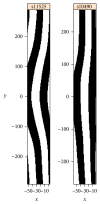Shaped singular spectrum analysis for quantifying gene expression, with application to the early Drosophila embryo
- PMID: 25945341
- PMCID: PMC4402483
- DOI: 10.1155/2015/689745
Shaped singular spectrum analysis for quantifying gene expression, with application to the early Drosophila embryo
Abstract
In recent years, with the development of automated microscopy technologies, the volume and complexity of image data on gene expression have increased tremendously. The only way to analyze quantitatively and comprehensively such biological data is by developing and applying new sophisticated mathematical approaches. Here, we present extensions of 2D singular spectrum analysis (2D-SSA) for application to 2D and 3D datasets of embryo images. These extensions, circular and shaped 2D-SSA, are applied to gene expression in the nuclear layer just under the surface of the Drosophila (fruit fly) embryo. We consider the commonly used cylindrical projection of the ellipsoidal Drosophila embryo. We demonstrate how circular and shaped versions of 2D-SSA help to decompose expression data into identifiable components (such as trend and noise), as well as separating signals from different genes. Detection and improvement of under- and overcorrection in multichannel imaging is addressed, as well as the extraction and analysis of 3D features in 3D gene expression patterns.
Figures




















Similar articles
-
Shaped 3D singular spectrum analysis for quantifying gene expression, with application to the early zebrafish embryo.Biomed Res Int. 2015;2015:986436. doi: 10.1155/2015/986436. Epub 2015 Oct 1. Biomed Res Int. 2015. PMID: 26495320 Free PMC article.
-
Automated annotation of developmental stages of Drosophila embryos in images containing spatial patterns of expression.Bioinformatics. 2014 Jan 15;30(2):266-73. doi: 10.1093/bioinformatics/btt648. Epub 2013 Dec 3. Bioinformatics. 2014. PMID: 24300439 Free PMC article.
-
[Dynamic filtration of the variability of expression patterns of zygotic segmentation genes in Drosophila].Biofizika. 2008 May-Jun;53(3):475-81. Biofizika. 2008. PMID: 18634321 Russian.
-
The importance of geometry in mathematical models of developing systems.Curr Opin Genet Dev. 2012 Dec;22(6):547-52. doi: 10.1016/j.gde.2012.09.007. Epub 2012 Oct 27. Curr Opin Genet Dev. 2012. PMID: 23107453 Free PMC article. Review.
-
[Methods for acquisition of quantitative from confocal images of gene expression in situ].Tsitologiia. 2008;50(4):352-69. Tsitologiia. 2008. PMID: 18664119 Review. Russian.
Cited by
-
Two-Exponential Models of Gene Expression Patterns for Noisy Experimental Data.J Comput Biol. 2018 Nov;25(11):1220-1230. doi: 10.1089/cmb.2017.0063. Epub 2018 Aug 17. J Comput Biol. 2018. PMID: 30117746 Free PMC article.
-
Shaped 3D singular spectrum analysis for quantifying gene expression, with application to the early zebrafish embryo.Biomed Res Int. 2015;2015:986436. doi: 10.1155/2015/986436. Epub 2015 Oct 1. Biomed Res Int. 2015. PMID: 26495320 Free PMC article.
-
Quantification reveals early dynamics in Drosophila maternal gradients.PLoS One. 2021 Aug 19;16(8):e0244701. doi: 10.1371/journal.pone.0244701. eCollection 2021. PLoS One. 2021. PMID: 34411119 Free PMC article.
-
Quantifying the roles of space and stochasticity in computer simulations for cell biology and cellular biochemistry.Mol Biol Cell. 2021 Jan 15;32(2):186-210. doi: 10.1091/mbc.E20-08-0530. Epub 2020 Nov 25. Mol Biol Cell. 2021. PMID: 33237849 Free PMC article.
References
Publication types
MeSH terms
Substances
Grants and funding
LinkOut - more resources
Full Text Sources
Other Literature Sources
Molecular Biology Databases
Research Materials

